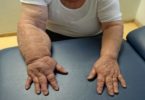What's in this article?
What is Scoliosis?
Scoliosis is a lateral (toward the side) curvature in the normally straight vertical line of the spine. When viewed from the side, the spine should show a mild roundness in the upper back and shows a degree of swayback (inward curvature) in the lower back. When a person with a normal spine is viewed from the front or back, the spine appears to be straight. When a person with scoliosis is viewed from the front or back, the spine appears to be curved.
Symptoms of Scoliosis
Signs and symptoms of scoliosis may include:
- Uneven shoulders
- One shoulder blade that appears more prominent than the other
- Uneven waist
- One hip higher than the other
If a scoliosis curve gets worse, the spine will also rotate or twist, in addition to curving side to side. This causes the ribs on one side of the body to stick out farther than on the other side. Severe scoliosis can cause back pain and difficulty breathing.
What causes Scoliosis?
Scoliosis can affect about 2% of females and 0.5% of males. In most cases, the cause of scoliosis is unknown (idiopathic). This type of scoliosis is described based on the age when scoliosis develops. If the person is less than 3 years old, it is called infantile idiopathic scoliosis. Scoliosis that develops between 3 and 10 years of age is called juvenile idiopathic scoliosis, and people that are over 10 years old have adolescent idiopathic scoliosis. More than 80% of people with scoliosis have idiopathic scoliosis, and the majority of those are adolescent girls.

There are three other main types of scoliosis:
- Functional: In this type of scoliosis, the spine is normal, but an abnormal curve develops because of a problem somewhere else in the body. This could be caused by one leg being shorter than the other or by muscle spasms in the back.
- Neuromuscular: In this type of scoliosis, there is a problem when the bones of the spine are formed. Either the bones of the spine fail to form completely or they fail to separate from each other during fetal development. This type of scoliosis develops in people with other disorders, including birth defects, muscular dystrophy, cerebral palsy, or Marfan’s disease. People with these conditions often develop a long C-shaped curve and have weak muscles that are unable to hold them up straight. If the curve is present at birth, it is called congenital. This type of scoliosis is often much more severe and needs more aggressive treatment than other forms of scoliosis.
- Degenerative: Unlike the other forms of scoliosis that are found in children and teens, degenerative scoliosis occurs in older adults. It is caused by changes in the spine due to arthritis known as spondylosis. Weakening of the normal ligaments and other soft tissues of the spine combined with abnormal bone spurs can lead to an abnormal curvature of the spine. The spine can also be affected by osteoporosis, vertebral compression fractures, and disc degeneration.
- Others: There are other potential causes of scoliosis, including spine tumors such as osteoid osteoma. This is a benign tumor that can occur in the spine and cause pain. The pain causes people to lean to the opposite side to reduce the amount of pressure applied to the tumor. This can lead to a spinal deformity.
Other Types of Scoliosis
While adolescent scoliosis is the most common, other common types of scoliosis include:
- Congenital scoliosis, which is present in infants
- Neuromuscular scoliosis, which is the results of neuromuscular conditions
- Degenerative scoliosis, which occurs later in life
How is Scoliosis Diagnosed?
Doctors use a medical and family history, physical exam, and tests when checking a person for scoliosis. An x ray of the spine can help the doctor decide if a person has scoliosis. The x ray lets the doctor measure the curve in degrees (such as 25 degrees) and see its location, shape, and pattern.

Treatment of Scoliosis
Treatment depends on many things:
- The cause of scoliosis
- Where the curve is in your spine
- How big the curve is
- If your body is still growing
Most people with idiopathic scoliosis do not need treatment. But you should still be checked by a doctor about every 6 months.
If you are still growing, your doctor might recommend a back brace. A back brace prevents further curving. There are many different types of braces. What kind you get depends on the size and location of your curve. Your health care provider will pick the best one for you and show you how to use it. Back braces can be adjusted as you grow.
Back braces work best in people over age 10. Braces do not work for those with congenital or neuromuscular scoliosis.
Sometimes, surgery is needed:
- Scoliosis surgery involves correcting the curve as much as possible.
- The spine bones are held in place with one or two metal rods. The rods are held down with hooks and screws until the bone heals together.
- Surgery may be done with a cut through the back, belly area, or beneath the ribs.
After surgery, you may need to wear a brace for a while to keep the spine still.
You may need surgery if the spine curve is severe or getting worse very quickly. The surgeon may want to wait until all your bones stop growing, but this is not always possible.
Scoliosis treatment may also include:
- Emotional support. Some children, especially teens, may be self-conscious when using a back brace.
- Physical therapy and other specialists to help explain the treatments and make sure the brace fits correctly.





